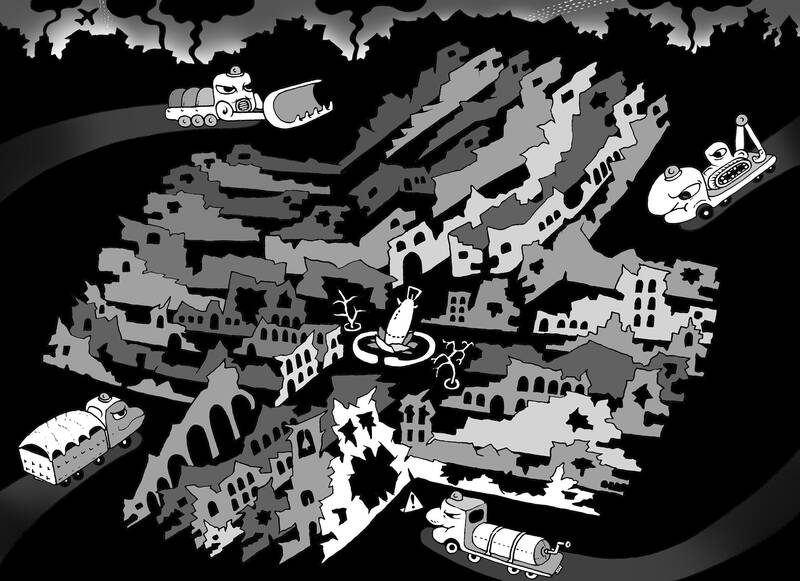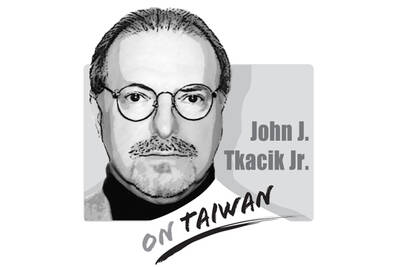As orders for its backup electricity generators surged in Ukraine, Turkish company Aksa Power Generation dispatched a dedicated manager to Kyiv, but Salih Komurcu’s job was not just to oversee the business in the war-hit country. It was also about what happens when the bombs eventually stop.
The situation on the front line offers no sense of when or how Russia’s war against its neighbor might end. Ukrainian setbacks have darkened the mood in Kyiv of late, but a growing phalanx of companies is gradually increasing its presence on the ground with the prospect of the biggest investment opportunity since at least World War II when it does.
Governments, executives and investors are positioning themselves in anticipation of a reconstruction that the European Investment Bank estimates could amount to more than US$1 trillion of public and private capital. Adjusted for inflation, that is more than five times as big as the US-funded Marshall Plan that powered the industrial renaissance in Europe following Germany’s defeat.

Illustration: Mountain People
A look at the rebuilding activity across Ukraine gives an idea of what the large-scale effort might look like.
Turkish firms are restoring bridges and roads, while providing energy generators and mobile hospitals, hoping to have an edge when the competition for big-ticket contracts gets going. Although little of it so far is for the longer term; it more about patching battle scars.
Looking further out, German and Austrian companies are planning ventures in infrastructure and defense, JPMorgan Chase & Co is waiting for working groups for “preproject planning,” while Denmark has donated 120 million euros (US$131 million) to rebuild the shipbuilding hub of Mykolaiv.
“Everyone is building their circles,” Komurcu said. “I want to be in the middle of it, among the people who were here in advance — and knowing everyone.”
Where the rebuilding takes place is likely to show what a future Ukraine might look like. Billions of dollars are slated for the swathe of the country controlled by Ukrainian President Volodymyr Zelenskiy’s government, but about 18 percent of Ukraine is occupied by Russia.
The map of Ukraine would depend on how much of that territory is taken back by Kyiv, and when and where more than one-quarter of the country’s prewar population would opt to live. About 3.7 million citizens still remain internally displaced, nearly 6.5 million have fled abroad and millions live under Russian occupation.
An area of about 156,000km2 — almost twice the size of Austria — has been affected by mines and other munitions, Ukrainian Minister of Economic Development and Trade Yulia Svyrydenko has said.
For those reasons, the man in charge of the rebuilding project in Ukraine said he is not yet able to paint a picture of the shape of his nation once the war ends.
Questions also include how to guarantee that the Russian aggressors do not return should there be some sort of peace accord and how a country plagued by corruption would process the incoming aid.
“We have a chance to rebuild better than it was in the USSR. A kind of a machine that will work — confident and transparent — when the funds come,” Ukrainian State Agency for Restoration and Infrastructure Development head Mustafa Nayyem said in his office in Kyiv.
For now, Ukraine is struggling to get aid to support its flagging war effort, let alone rebuild the country. A breakthrough came at the beginning of last month when Hungary dropped its opposition to the EU’s 50 billion euros aid package.
Yet on the ground, work is being done to keep the country running and gear up for reconstruction. Ukrainian energy firms have patched up battered infrastructure and agricultural companies are restoring silos and transit routes.
The biggest steelmaker, Metinvest BV, estimates that once large-scale reconstruction starts, about 3.2 million tonnes of steel would be needed to restore housing and social infrastructure over five to 10 years.
The company has said it is ready to meet that demand.
German companies are following their government, which is supporting Ukraine. Defense giant Rheinmetall AG last month announced plans to set up a venture in Ukraine to produce much needed 155mm artillery ammunition.
Building materials manufacturer Fixit has been constructing a production site in the west of Ukraine since last year, while chemical firm Bayer has announced investments in seed production.
Waagner-Biro Bridge Systems, an Austrian company that makes modular steel overpasses that span rivers and valleys, has already started some production at a site in western Ukraine.
Waagner-Biro CEO Richard Kerschbaumer said in an interview last year that “there will be plenty of work for decades.”
Given where the money is expected to come from, US and European companies are likely to get the lion’s share of the contracts when they come.
However, Turkey is pushing ahead in the meantime.
Turkish building contractors have completed 70 projects in Ukraine over the two years of war that were worth about US$1 billion, Turkish Minister of Trade Omer Bolat said earlier this year.
The biggest of them, Onur Group, is repairing blown-up bridges, such as the one at Irpin on the outskirts of Kyiv.
Teaming with South Korea’s Samsung C&T Corp, Onur Group is also building mobile hospitals in Ukraine. The company eventually wants to resume redevelopment of Dnipro International Airport along with some highway projects.
“We’ve got more than 4,000 pieces of machinery here and we’re committed to Ukraine and never considered abandoning it,” said Emre Karaahmetoglu, general coordinator for Onur in Ukraine.
The company’s most pressing challenge is finding workers because of army conscription, he said.
While competition for contracts is going to be huge, Turkish companies hope their experience of working in countries that have struggled with conflict or corruption will give them an advantage.
Istanbul-based Dogus Construction, already in Ukraine for years, is rebuilding three bridges with backing from the UK, and expects contracts worth “a couple of billion dollars” from the reconstruction effort one day, Dogus country representative in Ukraine Suha Canatan said.
As Russia rearms more quickly than Ukraine, the stalemate in the war might not hold for long. Zelenskiy has been imploring the US to follow Europe and renew its aid package, but even if it does, resources of ammunition are now more scarce.
Yet companies say that whatever happens in the near term, reconstruction must come at some point. More of the corporate mood music is how to make sure they are prepared for it.
Away from Ukraine, for example, Hungarian engineering firm Ganz-Mavag has said part of the rationale for bidding to buy Spanish train maker Talgo was to scale up capacity to meet demand in eastern Europe over the next decade, driven by the Ukrainian reconstruction once it starts.
In Mykolaiv, consultants and local authorities are drafting a master plan that looks ahead to 2050. Much of it remains on paper only, as further progress cannot be made before the war ends, said Jesper Karup Pedersen, technical director and project manager for Cowi, a Danish engineering consultancy working on the Mykolaiv redevelopment.
“Many of the projects can be bomb targets,” he said.
Often simple tasks such as sourcing documents from local authorities are tough, because people are whisked off to the front lines, creating gaps in the state administration, he said.
Most of the Danish funds for the municipality were so far used to buy generators, water pumps and heaters, and support de-mining efforts in the city whose population has shrunk since the invasion two years ago.
Still, even those first steps are paying off. There are already visible signs that people have started to return to Mykolaiv.
During his last visit to the town in January, Danish Ambassador to Ukraine Ole Egberg Mikkelsen said he experienced a traffic jam for the first time since the war.
Mikkelsen said he hopes Danish companies will one day benefit from their nation’s good reputation in Ukraine as they explore commercial opportunities in the country.
“We have the approach that we must do something now,” he said. “We cannot wait for the war to be over and for reconstruction conferences to have taken place.”
For sure, new industries are putting down roots, with defense and technology rising in importance and contribution to Ukraine’s economy. Agriculture, the main driver of growth, is undergoing the biggest revamp in decades.
The European Bank for Reconstruction and Development (EBRD), which has provided 3.8 billion euros in financing for Ukraine since the war started, said that the focus should not be only on the money, but also on people, EBRD chief economist Beata Javorcik said.
Indeed, the success of the biggest investment project since World War II requires the patience of Ukrainians, and whether Russia can be trusted to adhere to any peace deal, Nayyem said.
“Many people think in terms of ‘the war will end and ...,’ but we do not know when it will end,” Nayyem said. “And even when it ends, what shall we do with such a neighbor? We will definitely need a long time to restore territories that were liberated or on the front line.”
Chinese agents often target Taiwanese officials who are motivated by financial gain rather than ideology, while people who are found guilty of spying face lenient punishments in Taiwan, a researcher said on Tuesday. While the law says that foreign agents can be sentenced to death, people who are convicted of spying for Beijing often serve less than nine months in prison because Taiwan does not formally recognize China as a foreign nation, Institute for National Defense and Security Research fellow Su Tzu-yun (蘇紫雲) said. Many officials and military personnel sell information to China believing it to be of little value, unaware that
Before 1945, the most widely spoken language in Taiwan was Tai-gi (also known as Taiwanese, Taiwanese Hokkien or Hoklo). However, due to almost a century of language repression policies, many Taiwanese believe that Tai-gi is at risk of disappearing. To understand this crisis, I interviewed academics and activists about Taiwan’s history of language repression, the major challenges of revitalizing Tai-gi and their policy recommendations. Although Taiwanese were pressured to speak Japanese when Taiwan became a Japanese colony in 1895, most managed to keep their heritage languages alive in their homes. However, starting in 1949, when the Chinese Nationalist Party (KMT) enacted martial law

“Si ambulat loquitur tetrissitatque sicut anas, anas est” is, in customary international law, the three-part test of anatine ambulation, articulation and tetrissitation. And it is essential to Taiwan’s existence. Apocryphally, it can be traced as far back as Suetonius (蘇埃托尼烏斯) in late first-century Rome. Alas, Suetonius was only talking about ducks (anas). But this self-evident principle was codified as a four-part test at the Montevideo Convention in 1934, to which the United States is a party. Article One: “The state as a person of international law should possess the following qualifications: a) a permanent population; b) a defined territory; c) government;
The central bank and the US Department of the Treasury on Friday issued a joint statement that both sides agreed to avoid currency manipulation and the use of exchange rates to gain a competitive advantage, and would only intervene in foreign-exchange markets to combat excess volatility and disorderly movements. The central bank also agreed to disclose its foreign-exchange intervention amounts quarterly rather than every six months, starting from next month. It emphasized that the joint statement is unrelated to tariff negotiations between Taipei and Washington, and that the US never requested the appreciation of the New Taiwan dollar during the